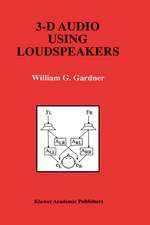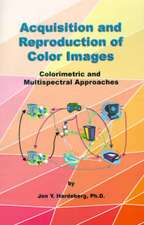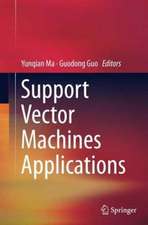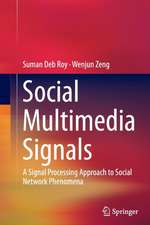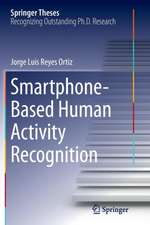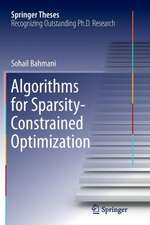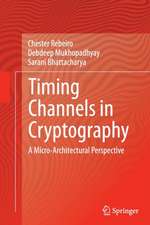A Survey of Blur Detection and Sharpness Assessment Methods: Synthesis Lectures on Algorithms and Software in Engineering
Autor Juan Andradeen Limba Engleză Paperback – 5 ian 2021
Automatic estimation of spatially varying sharpness/blurriness has several applications including depth estimation, image quality assessment, information retrieval, image restoration, among others.
There are some cases in which blur is intentionally introduced or enhanced; for example, in artistic photography and cinematography in which blur is intentionally introduced to emphasize a certain image region. Bokeh is a technique that introduces defocus blur with aesthetic purposes. Additionally, in trending applications like augmented and virtual reality usually, blur is introduced in order to provide/enhance depth perception.
Digital images and videos are produced every day in astonishing amounts and the demand for higher quality is constantly rising which creates a need for advanced image quality assessment. Additionally, image quality assessment is important for the performance of image processing algorithms. It has been determined that image noise and artifacts can affect the performance of algorithms such as face detection and recognition, image saliency detection, and video target tracking. Therefore, image quality assessment (IQA) has been a topic of intense research in the fields of image processing and computer vision. Since humans are the end consumers of multimedia signals, subjective quality metrics provide the most reliable results; however, their cost in addition to time requirements makes them unfeasible for practical applications. Thus, objective quality metrics are usually preferred.
Din seria Synthesis Lectures on Algorithms and Software in Engineering
-
 Preț: 380.37 lei
Preț: 380.37 lei -
 Preț: 260.95 lei
Preț: 260.95 lei -
 Preț: 384.31 lei
Preț: 384.31 lei -
 Preț: 351.11 lei
Preț: 351.11 lei -
 Preț: 262.47 lei
Preț: 262.47 lei -
 Preț: 206.29 lei
Preț: 206.29 lei -
 Preț: 192.63 lei
Preț: 192.63 lei -
 Preț: 206.29 lei
Preț: 206.29 lei -
 Preț: 261.91 lei
Preț: 261.91 lei -
 Preț: 192.05 lei
Preț: 192.05 lei -
 Preț: 204.76 lei
Preț: 204.76 lei -
 Preț: 204.76 lei
Preț: 204.76 lei -
 Preț: 414.65 lei
Preț: 414.65 lei -
 Preț: 192.41 lei
Preț: 192.41 lei -
 Preț: 389.88 lei
Preț: 389.88 lei -
 Preț: 205.92 lei
Preț: 205.92 lei -
 Preț: 260.56 lei
Preț: 260.56 lei -
 Preț: 207.83 lei
Preț: 207.83 lei -
 Preț: 266.70 lei
Preț: 266.70 lei -
 Preț: 381.43 lei
Preț: 381.43 lei
Preț: 379.48 lei
Nou
Puncte Express: 569
Preț estimativ în valută:
72.62€ • 75.02$ • 60.44£
72.62€ • 75.02$ • 60.44£
Carte tipărită la comandă
Livrare economică 26 martie-09 aprilie
Preluare comenzi: 021 569.72.76
Specificații
ISBN-13: 9783031004018
ISBN-10: 3031004019
Pagini: 95
Ilustrații: XVII, 95 p.
Dimensiuni: 191 x 235 mm
Greutate: 0.21 kg
Editura: Springer International Publishing
Colecția Springer
Seria Synthesis Lectures on Algorithms and Software in Engineering
Locul publicării:Cham, Switzerland
ISBN-10: 3031004019
Pagini: 95
Ilustrații: XVII, 95 p.
Dimensiuni: 191 x 235 mm
Greutate: 0.21 kg
Editura: Springer International Publishing
Colecția Springer
Seria Synthesis Lectures on Algorithms and Software in Engineering
Locul publicării:Cham, Switzerland
Cuprins
Preface.- Acknowledgments.- Introduction.- Out-of-Focus Blur.- Image Quality Assessment.- No-Reference Image Assessment.- Summary and Future Directions.- Bibliography.- Author's Biography .
Notă biografică
Juan Andrade was born in Cuenca, Ecuador on October 25, 1972. He received his B.Sc. degree in electrical engineering from the University of Cuenca. In 2000, he received a Master’s degree in mobile communications from Polytechnic University of Catalonia Barcelona-Spain, and his M.Sc. and Ph.D. from Arizona State University in 2005 and 2019, respectively. He is a professor at the University of Cuenca where he is the director of the school of telecommunication engineering. His current research interests include signal and image processing, computer vision, and image understanding.





